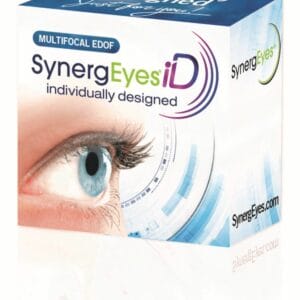April 11, 2023
While we have already discussed success with contact lens fitting for our presbyopic population, including patient selection and ocular surface management, the most time in our clinic spent on a presbyopic contact lens evaluation is dedicated to managing patient expectations. No two patients are the same, and their preconceived expectations, fears, and trepidations can vary greatly. We have to approach contact lens evaluations the same way we approach patient education on ocular disease—there is no such thing as too much information.
First we must educate patients on the condition of presbyopia and reassure them that this should not come as a surprise because it is something everyone in “Generation 45+” will experience. Many patients come to us extremely concerned, especially the emmetropes or low hyperopes who have never had to worry about their eyes or vision. This has led us to start proactively discussing what our pre-presbyopic patients can expect in their 40s. It is especially important to discuss the fact that there are ways to correct their blurry vision when the patient notices symptoms.
Sometimes it’s the post-LASIK patient in our chair who conveniently wasn’t paying attention when they were told they would need glasses in the future. The conversation alone about the condition can mollify a concerned patient. Thankfully, the vast majority of patients have been warned about this by their friends, coworkers, or by their eye care provider. However, they likely still don’t know all of the options available.
Help Is On the Way!
Then we get to tell the patient how we are going to help them! At this point, we present all options available to the patient: Rx/OTC readers, progressive or bifocal glasses, contact lenses, and prescription miotic eye drops. As discussed earlier, every patient is unique, and no single option will be best for everyone. So it is up to us to present all potential solutions to each patient and open the floor for discussion to figure out what is going to work best for them. This gives the patient the luxury of choice to decide how they want to experience their vision.
So, now we have a presbyope in our chair who understands what’s going on with their vision, knows what tools we have in our arsenal to alleviate their woes of short arms and brow aches, and is eager to get started with their contact lens evaluation. But, of course, there is still more discussion to be had. What kind of goals is the patient expecting from their contacts? Are they an everyday wearer? Do they just want to wear them for hobbies? How much computer/near work are they doing? What are their hobbies, and do they have different visual demands than work? Did they say ‘yes’ to all of these things?
If We Could Turn Back Time . . . But We Can’t
We also need to stress to the patient that there is no perfect option that will turn back time for their eyes to become as they were back to their 20s. It’s important to achieve our patient’s goals, but they need to be reasonable. Our goal is to provide functional vision for day-to-day life. If a patient needs to have modifications for specific activities, we can make alternative prescriptions for different visual demands. There is no limit to the number of prescriptions each patient can have for their contact lenses.
We have to know what potential problems the patient may face before they actually become real problems so that we can maximize contact lens success. Once we know what the patient expects, then we can look to see if we can meet their expectations. What’s their refractive error? Are they a hyperope, myope, and/or astigmat? What’s their binocular status and ocular surface health like? What about eye dominance? Already, it seems like there’s a million things to consider before fitting a presbyope in contacts, which is what makes this process fun, challenging, and rewarding all at the same time. It truly is an art rather than science.
Multifocals or Monovision? Your Brain Knows
So, once we’ve extracted all of the important subjective and objective data from the patient, it’s finally time to face the age-old question: multifocals or monovision? This question may have answered itself in eons past if a patient had considerable astigmatism or high refractive error, but technologies have advanced so far that there’s often an option for everyone who sits in your chair. At this point, you should have a few potential options for lens design and modality and can weigh the pros and cons with the patient and discuss why a particular option would likely work best. You are the doctor, of course, and you have more experience with this, but patient care is a collaborative effort.
We’ve selected our lenses, and it’s finally time to get the “wow” effect both you and the patient are looking for. There’s one last little bit of patient education we are going to cram in before plastic meets cornea. This is going to be a gear shift for the patient’s brain, and it’s going to take some getting used to. If the patient is being fit in monovision, the patient is going to have one eye blurry at any given time. For multifocals, the brain is going to receive clear (and blurry) images for distance, intermediate, and near simultaneously. It’s important to explain that the patient’s brain is going to have to learn to filter out the “noise,” which it’s extremely good at learning. Can the patient feel their hair laying on the back of their neck? Or their socks on their feet? Well, they can now that you mentioned it, but not usually, no. Their brain is going to attend to all this new information, so the vision will probably be a little blurry at first. But you can reassure them before they even put on the lenses that this day should be the worst vision they’ll experience but every day will get better. It’s also important to explain that glasses will likely provide sharper vision at all ranges, but this usually isn’t a deal-breaker to the patient considering the convenience of contacts.
Managing our patient’s expectations starts from the beginning of the eye exam all the way until they walk out the door, and it’s a crucial factor in successfully fitting presbyopic contacts. Because each patient is unique, they have to be approached uniquely. There are more factors and potential roadblocks at play that require us as prescribing physicians to anticipate and deftly maneuver through compared to a standard contact lens evaluation. Eye care providers should recognize the time and skill this takes and make certain we are compensated appropriately for that expertise when fitting our presbyopic patients. But, above all else, we hope this article reminds you of how fun, challenging, and rewarding the art of providing clear vision at all ranges to a demanding and diverse patient population can be!





